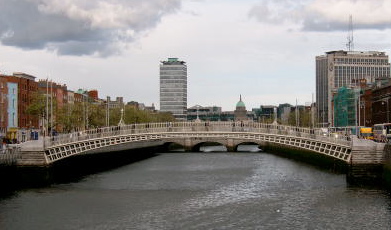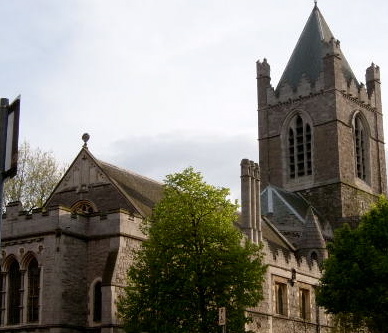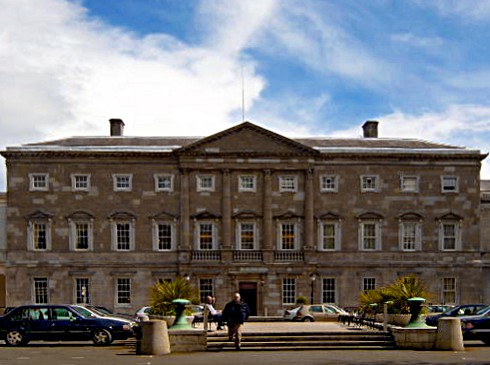| Revision as of 19:25, 5 May 2003 editJtdirl (talk | contribs)Extended confirmed users24,275 edits images added← Previous edit | Revision as of 19:48, 5 May 2003 edit undoJtdirl (talk | contribs)Extended confirmed users24,275 edits images adaptedNext edit → | ||
| Line 5: | Line 5: | ||
| <div style="float:right; width: |
<div style="float:right; width:391px; padding:2px; margin-left:1em; text-align:center"> | ||
| ]<br>'''Dublin's famous ha'penny Bridge'''<br><small>Beyond it, the dome of the eighteenth century Custom House and Liberty Hall, Dublin's tallest building</small>]<br>'''11th century Christchurch Cathedral'''</div>Dublin has a population of 495,000 (2002 Census) within the official city boundary which has become largely meaningless with the development and spread of suburbs and satellite towns over a wide surounding area. The population of Dublin County (including the City} is in excess of 1,100,000 (2002 Census). Though there is no exact agreed definition of the "Greater Dublin" area it would be generally accepted as including all of the city and county and parts of Counties Wicklow, Kildare and Meath with the limits of the commuter belt stretching to a much greater distance. | ]<br>'''Dublin's famous ha'penny Bridge'''<br><small>Beyond it, the dome of the eighteenth century Custom House and Liberty Hall, Dublin's tallest building</small>]<br>'''11th century Christchurch Cathedral'''</div>Dublin has a population of 495,000 (2002 Census) within the official city boundary which has become largely meaningless with the development and spread of suburbs and satellite towns over a wide surounding area. The population of Dublin County (including the City} is in excess of 1,100,000 (2002 Census). Though there is no exact agreed definition of the "Greater Dublin" area it would be generally accepted as including all of the city and county and parts of Counties Wicklow, Kildare and Meath with the limits of the commuter belt stretching to a much greater distance. | ||
| Line 18: | Line 18: | ||
| ==National Government== | ==National Government== | ||
| <div style="float:right; width: |
<div style="float:right; width:461px; padding:2px; margin-left:1em; text-align:center"> | ||
| ]<br>'''Leinster House'''<br><small>18th century ducal palace now the seat of parliament.</small></div> | ]<br>'''Leinster House'''<br><small>18th century ducal palace now the seat of parliament.</small></div> | ||
| The ], which was founded on ] ], ], based its parliament, ], in Dublin, in a former dual palace called ]. The ], who represented the King, resided in the ] in the city largest park, ]. | The ], which was founded on ] ], ], based its parliament, ], in Dublin, in a former dual palace called ]. The ], who represented the King, resided in the ] in the city largest park, ]. | ||
Revision as of 19:48, 5 May 2003
Dublin (Irish language: Baile Átha Cliath) is the capital and largest city of the Republic of Ireland.

Dublin's famous ha'penny Bridge
Beyond it, the dome of the eighteenth century Custom House and Liberty Hall, Dublin's tallest building

11th century Christchurch Cathedral
Dublin has a population of 495,000 (2002 Census) within the official city boundary which has become largely meaningless with the development and spread of suburbs and satellite towns over a wide surounding area. The population of Dublin County (including the City} is in excess of 1,100,000 (2002 Census). Though there is no exact agreed definition of the "Greater Dublin" area it would be generally accepted as including all of the city and county and parts of Counties Wicklow, Kildare and Meath with the limits of the commuter belt stretching to a much greater distance.
Founded by the Vikings in the 10th century, Dublin became the centre of English power in Ireland after the 12th century Norman conquest of half of Ireland (Munster and Leinster). Over time, however, many of the Anglo-Norman conquerors were absorbed into the Irish culture, adopting the Irish language and customs, leaving a small area around Dublin called the Pale under direct English control. People outside this area were still considered savage, giving rise to the expression "Beyond the Pale".
By the beginning of the 18th century the English had re-established control and imposed the harsh Penal Laws on the Catholic majority of Ireland's population. In Dublin however the Protestant ascendency was thriving, and the city expanded rapidly from the 17th century onward.
In 1782-1800 the city housed an independent (though still exclusively Protestant) Irish Parliament, and it was during this period that much of the great Georgian buildings of Dublin were built. In 1801 under the Act of Union, Ireland lost this parliament and with it much of its political influence, though the city's growth continued.
In 1916 the British crushed the Republican Easter Rising in the city. Between 1919 and 1921 Ireland experienced the Irish War of Independence. The result was the Anglo-Irish Treaty between Britain and Ireland which created the Irish Free State.
National Government

Leinster House
18th century ducal palace now the seat of parliament.
The Irish Free State, which was founded on December 6, 1922, based its parliament, Oireachtas Éireann, in Dublin, in a former dual palace called Leinster House. The Governor-General of the Irish Free State, who represented the King, resided in the Viceregal Lodge in the city largest park, Phoenix Park.
In 1937, a new constitution, called Bunreacht na hÉireann, created the new state called Éire (called since 1949 the Republic of Ireland). The President of Ireland now lives in the renamed Viceregal Lodge, known as Áras an Uachtaráin. The Oireachtas remains in Leinster House.
City Government
Dublin City is governed by Dublin City Council (formerly called Dublin Corporation) with is presided over by the Lord Mayor of Dublin.
County Dublin
Dublin (often referred to as County Dublin) was also the name of one of Ireland's thirty-two counties and a local government administrative unit. In the late twentieth century, was divided in four, producing four counties or administrative units, namely
- Dublin City
- Dublin County
- Dun Laoghaire-Rathdown
- Fingal
Areas of Dublin City:
- North side
- South side
Events

Powerscourt Townhouse Centre
18th century decor in a stately mansion, now turned into a shopping centre.
- 1853 - Great Industrial Exhibition (1853)
- 1865 - International Exhibition of Arts and Manufactures (1865)
- 1874 - International Exhibition of Arts and Manufactures (1874)
- 1907 -
See also
External links
- contains explanation of English and Irish language names of the city.
County Dublin covers an area of 922 km and contains over a million inhabitants.
Dublin is also a name of some places in the United States of America:
- Dublin, California
- Dublin, Georgia
- Dublin, New Hampshire
- Dublin, Ohio
- Dublin, Virginia
- Dublin Township, Pennsylvania
There is also Upper Dublin, Pennsylvania.